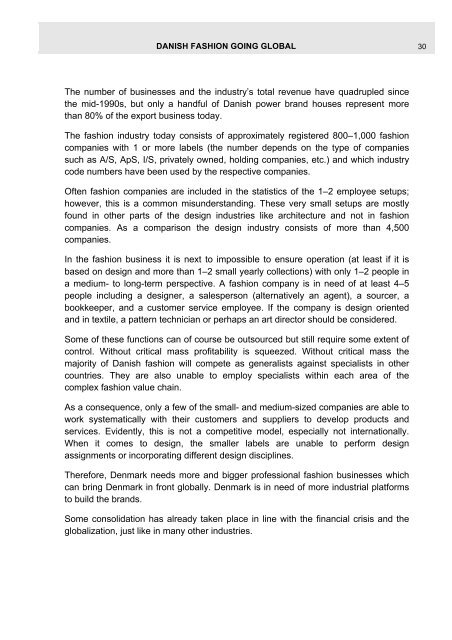Danish Fashion Going Global - Spandet And Partners
Danish Fashion Going Global - Spandet And Partners
Danish Fashion Going Global - Spandet And Partners
You also want an ePaper? Increase the reach of your titles
YUMPU automatically turns print PDFs into web optimized ePapers that Google loves.
DANISH FASHION GOING GLOBAL 30<br />
The number of businesses and the industry’s total revenue have quadrupled since<br />
the mid-1990s, but only a handful of <strong>Danish</strong> power brand houses represent more<br />
than 80% of the export business today.<br />
The fashion industry today consists of approximately registered 800–1,000 fashion<br />
companies with 1 or more labels (the number depends on the type of companies<br />
such as A/S, ApS, I/S, privately owned, holding companies, etc.) and which industry<br />
code numbers have been used by the respective companies.<br />
Often fashion companies are included in the statistics of the 1–2 employee setups;<br />
however, this is a common misunderstanding. These very small setups are mostly<br />
found in other parts of the design industries like architecture and not in fashion<br />
companies. As a comparison the design industry consists of more than 4,500<br />
companies.<br />
In the fashion business it is next to impossible to ensure operation (at least if it is<br />
based on design and more than 1–2 small yearly collections) with only 1–2 people in<br />
a medium- to long-term perspective. A fashion company is in need of at least 4–5<br />
people including a designer, a salesperson (alternatively an agent), a sourcer, a<br />
bookkeeper, and a customer service employee. If the company is design oriented<br />
and in textile, a pattern technician or perhaps an art director should be considered.<br />
Some of these functions can of course be outsourced but still require some extent of<br />
control. Without critical mass profitability is squeezed. Without critical mass the<br />
majority of <strong>Danish</strong> fashion will compete as generalists against specialists in other<br />
countries. They are also unable to employ specialists within each area of the<br />
complex fashion value chain.<br />
As a consequence, only a few of the small- and medium-sized companies are able to<br />
work systematically with their customers and suppliers to develop products and<br />
services. Evidently, this is not a competitive model, especially not internationally.<br />
When it comes to design, the smaller labels are unable to perform design<br />
assignments or incorporating different design disciplines.<br />
Therefore, Denmark needs more and bigger professional fashion businesses which<br />
can bring Denmark in front globally. Denmark is in need of more industrial platforms<br />
to build the brands.<br />
Some consolidation has already taken place in line with the financial crisis and the<br />
globalization, just like in many other industries.


